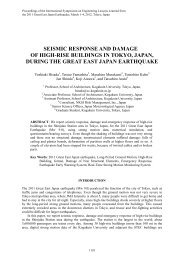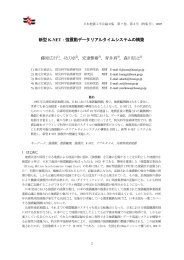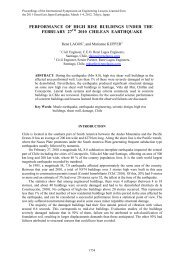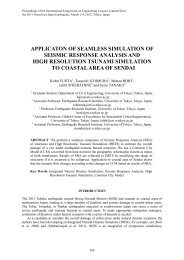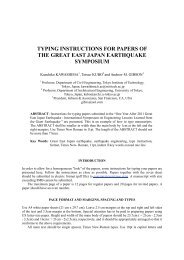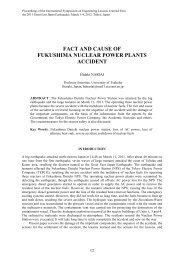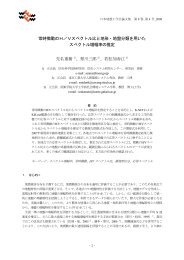Seismic Response Analysis of a Semi-active-controlled Base ...
Seismic Response Analysis of a Semi-active-controlled Base ...
Seismic Response Analysis of a Semi-active-controlled Base ...
You also want an ePaper? Increase the reach of your titles
YUMPU automatically turns print PDFs into web optimized ePapers that Google loves.
<strong>Seismic</strong> <strong>Response</strong> <strong>Analysis</strong><strong>Seismic</strong> response analyses with updated structural parameters are conducted for two seismic events:the main shock and the aftershock that occurred 30 minutes later. The acceleration response spectra <strong>of</strong>the records observed at the foundation slab are shown in Fig. 10.All three identifications are realized using the main shock data and their accuracy is checked usingthe aftershock data. Considering the identification measure error e, the three methods are comparedand the results are summarized in Table 5. Also, a time history portion is displayed in Fig. 11 to figureout the accuracy <strong>of</strong> identification. According to those results, the direct identification method gives thebest and most robust approximation; however, the computation time is more extensive.SA [cm/s 2 ]18016014012010080604020p p (ξ )main shockafter-shock00 2 4 6 8 10Period [s]300250a) NS directiong p p ξmain shockafter-shockSA [cm/s 2 ]2001501005000 2 4 6 8 10Period [s]b) EW directionFig. 10 Acceleration response spectra <strong>of</strong> the main shock and the 30-minute-later aftershockTable 5 Error eMain ShockAftershockIdentificationNS direction EW direction NS direction EW directionMethod[10 -3 ][10 -3 ][10 -3 ][10 -3 ]Initial 6.3 5.4 7.5 5.3ARX 2.9 2.8 2.9 2.3N4SID 4.6 3.3 5.9 3.1Direct 2.8 2.2 3.1 2.11033




